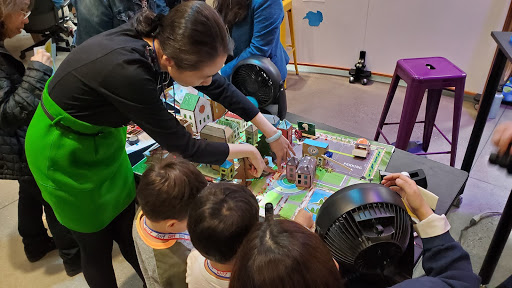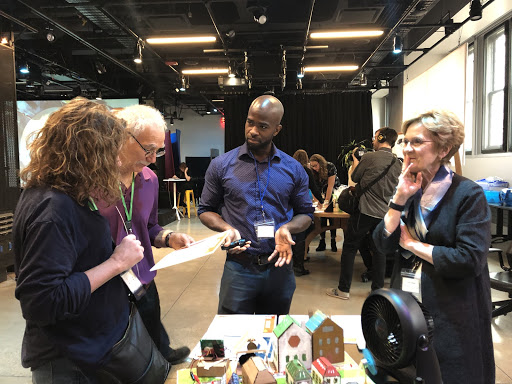The Fall 2019 STEAMnasium, produced by the Math, Science and Technology department, was held at Teachers College, Columbia University from 10:00am to 2:00pm at the Smith Learning Center on November 5th. The Center for Technology and School Change (CTSC) featured an electrical village project titled, Understanding Energy: Making Choices in Building a Healthy Community, an interactive hands-on session that invited teachers, alumni, professionals, parents, faculty, visiting educators, TC students and young learners of all ages to engage in a transdisciplinary STEAM project focused on guiding knowledge-building about sustainability and energy choices in our communities.

Kids participated in the interactive activities with facilitators
The interactive village used energy as a vehicle to engage participants in discussions about the big idea of sustainability. The science content focused on three forms of renewable energy and non-renewable energy: wind, solar, and chemical. STEAMnasium attendees had opportunities to interact with the three different energy sources and make critical decisions through proposed scenarios. To model the complexity of decision-making surrounding sustainability, the project presented students with scenarios that described various energy-based problems in the community such as the need to add lights to celebrate a village festival, or adding more stoplights to help with traffic flow. These scenarios were open-ended and required participants to draw on their newly acquired knowledge of energy and take into consideration the costs of utilizing the various sources. The scenarios were a gamification component of the project and provided choice in how visitors could engage with the village. Tokens were handed out as currency, symbolizing the value of each type of energy and reflecting the relative cost of each in comparison to the other. The energy cost was based on multiple factors including financial, energy efficiency, environmental effects, human labor in the city, etc.
The project encouraged students, teachers, and participating adults to think deeply about the use of energy in the local and global community. By scanning the QR codes on the Global Energy Expansion Map, participants could explore examples of alternative models of energy use around the world, including current projects in Singapore, Tanzania, Europe, Chile, and New York City. Technology as a purposeful tool helped visitors to not only learn about energy but also make choices in how they interacted with the activity and deepen their understanding of energy initiatives, most importantly, encouraging visitors to think critically about the decision-making processes in using energy wisely to support a global community.

Teachers are discussing and exchanging ideas with the project designers from CTSC
By positioning students as “knowledge-builders” and teachers as “designers”, the CTSC team modeled an accessible multi-age STEAM project. The village was built for the most part using recycled, repurposed, and inexpensive materials like cardboard, popsicle sticks, colored paper, copper wire tapes, and LEDs. It was intended for teachers to see that this was an example of a rigorous real-world and relevant interactive STEAM project that they could adapt and modify for their own teaching goals and classrooms, without investing a great deal of expense.
With teachers as designers of engaging, authentic and rigorous project-based learning, creative STEM-focused teaching challenges students to think critically, drive their own learning, and push to understand deeply. CTSC is proud to partner with teachers around the world to co-construct innovative inquiry-based learning environments that meet the needs of a wide variety of learners and learning styles.
CTSC STEAMnasium Team
(from left to right) Lauren Simon, Mary Metzger, Weiying Zhu, Dr. Sean Peters, Xiaoxue Du, Professor Ellen B.Meier
(not pictured) Karen Kirsch Page, Dr. Denise Mahfood, Caron Mineo, Lucy Smith, Seth McCall, Karina Diaz-Yanez, Maria Lopez-Delgado, Kathy Rodriguez, Guo Yue, Dr. Sharmin Hakim, and Kamille Way.
